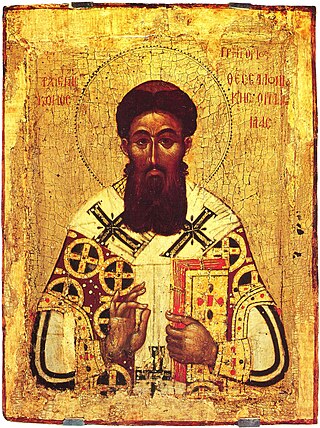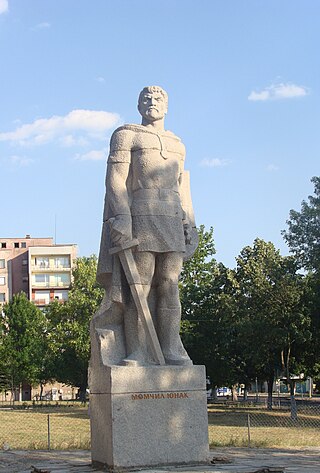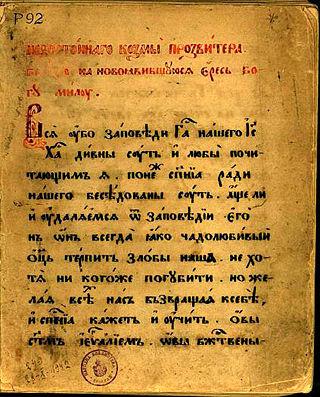Catharism was a Christian quasi-dualist or pseudo-Gnostic movement which thrived in Southern Europe, particularly in northern Italy and southern France, between the 12th and 14th centuries. Denounced as a heretical sect by the Catholic Church, its followers were attacked first by the Albigensian Crusade and later by the Medieval Inquisition, which eradicated the sect by 1350. Many thousands were slaughtered, hanged, or burnt at the stake, sometimes without regard for age or sex.

The Albigensian Crusade, also known as the Cathar Crusade (1209–1229), was a military and ideological campaign initiated by Pope Innocent III to eliminate Catharism in Languedoc, what is now southern France. The Crusade was prosecuted primarily by the French crown and promptly took on a political aspect. It resulted in the significant reduction of practicing Cathars and a realignment of the County of Toulouse with the French crown. The distinct regional culture of Languedoc was also diminished.

Gregory Palamas was a Byzantine Greek theologian and Eastern Orthodox cleric of the late Byzantine period. A monk of Mount Athos and later archbishop of Thessalonica, he is famous for his defense of hesychast spirituality, the uncreated character of the light of the Transfiguration, and the distinction between God's essence and energies. His teaching unfolded over the course of three major controversies, (1) with the Italo-Greek Barlaam between 1336 and 1341, (2) with the monk Gregory Akindynos between 1341 and 1347, and (3) with the philosopher Gregoras, from 1348 to 1355. His theological contributions are sometimes referred to as Palamism, and his followers as Palamites.
Bogomilism was a Christian neo-Gnostic, dualist sect founded in the First Bulgarian Empire by the priest Bogomil during the reign of Tsar Peter I in the 10th century. It most probably arose in the region of Kutmichevitsa, today part of the region of Macedonia.
The Euchites or Messalians were a Christian sect from Mesopotamia that spread to Asia Minor and Thrace. The name 'Messalian' comes from the Syriac ܡܨܠܝܢܐ, mṣallyānā, meaning 'one who prays'. The Greek translation is εὐχίτης, euchitēs, meaning the same.

The Bosnian Church was a schismatic Christian church in medieval Bosnia and Herzegovina that was independent from and considered heretical by both the Catholic and the Eastern Orthodox churches.

The strigolniki were followers of a Russian religious sect which appeared in the mid-14th century, known as strigolnichestvo. They first appeared in Pskov before spreading to Novgorod and Tver. By the early 15th century, they had disappeared. Along with the Judaizers, they were one of the major sects in medieval Russia.
Chernorizets Hrabar was a Bulgarian monk, scholar and writer who worked at the Preslav Literary School in the First Bulgarian Empire at the end of the 9th and the beginning of the 10th century. He is credited as the author of On the Letters.

Ivan Shishman ruled as emperor (tsar) of Bulgaria in Tarnovo from 1371 to 3 June 1395. The authority of Ivan Shishman was limited to the central parts of the Bulgarian Empire.

The First Bulgarian Empire was a medieval state that existed in Southeastern Europe between the 7th and 11th centuries AD. It was founded in 680–681 after part of the Bulgars, led by Asparuh, moved south to the northeastern Balkans. There they secured Byzantine recognition of their right to settle south of the Danube by defeating – possibly with the help of local South Slavic tribes – the Byzantine army led by Constantine IV. During the 9th and 10th century, Bulgaria at the height of its power spread from the Danube Bend to the Black Sea and from the Dnieper River to the Adriatic Sea and became an important power in the region competing with the Byzantine Empire.

Momchil was a 14th-century Bulgarian brigand and local ruler. Initially a member of a bandit gang in the borderlands of Bulgaria, Byzantium and Serbia, Momchil was recruited by the Byzantines as a mercenary. Through his opportunistic involvement in the Byzantine civil war of 1341–1347, where he played the various sides against each other, he became ruler of a large area in the Rhodopes and western Thrace.

Heresy is any belief or theory that is strongly at variance with established beliefs or customs, particularly the accepted beliefs or religious law of a religious organization. A heretic is a proponent of heresy.
Constantine Chrysomalus was a Byzantine monk who was posthumously condemned by a Synod of Constantinople as a teacher of heresies affiliated with Bogomilism and Messalianism. Although Chrysomalus and his writings, the Golden Sermons, had been accused of promoting Bogomil teachings, his association with Bogomilism has been contested by later scholars.
Strez was a medieval, semi-independent Bulgarian sebastokrator. He was a member of the Asen dynasty and a cousin or a brother of Boril of Bulgaria. A major contender for the Bulgarian throne, Strez initially opposed the ascension of his close relative Tsar Boril. He fled to Serbia, where he accepted the vassalage of Grand Prince Stefan Nemanjić, and Serbian support helped him establish himself as a largely independent ruler in a large part of the region of Macedonia. However, Strez turned against his suzerains to become a Bulgarian vassal and joined forces with his former enemy Boril against the Latins and then Serbia. Strez died amidst a major anti-Serbian campaign under unclear circumstances, sometimes described as a Serbian plot.
Hranislav was a Bulgarian military commander who was a close associate of rebel leader and later Tsar Ivaylo. After being captured by the Byzantines, Hranislav entered the service of Andronikos II Palaiologos as his megas tzaousios. As a Byzantine officer, he commanded a detachment which assisted the Catalan Company in the wars against the Anatolian Beyliks in Asia Minor.
Isbul was the kavhan, or first minister, of the First Bulgarian Empire during the reigns of Omurtag, Malamir and Presian I. Appointed to the kavhan office under Omurtag, Isbul was a regent or co-ruler of the underage Malamir and his successor Presian.

Cosmas the Priest, also known as Cosmas the Presbyter or Presbyter Cosmas, was a medieval Bulgarian priest and writer. Cosmas is most famous for his anti-Bogomil treatise Sermon Against the Heretics, which, despite not being conclusively dated, is generally ascribed to the 10th century. The treatise is a valuable source on the beginnings of the Bogomil heresy in Bulgaria, as well as on medieval Bulgarian society.
Jeremiah was a 10th-century Bulgarian priest and writer usually associated with the origins of Bogomilism. The earliest mention of him is found in a work of Patriarch Sisinnius II of Constantinople. He is sometimes associated with, though more often distinguished from, the priest Bogomil.
Bogomil was a 10th-century Bulgarian priest who was connected with the origins of Bogomilism. Bogomil is a Theophoric name consisting of Bog (God) and mil (dear) and means "[one who is] dear to god". He was declared a heresiarch by both the Catholic and Orthodox churches.
The Bosnian Crusade was fought against unspecified heretics from 1235 to 1241 and was essentially a Hungarian war of conquest against the Banate of Bosnia that was sanctioned as a crusade. Led by a Hungarian prince, Coloman, the crusaders succeeded in conquering only peripheral parts of the country. They were followed by Dominicans, who erected a cathedral and put heretics to death by burning.









